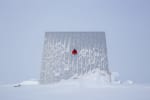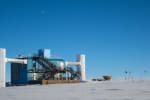The IceCube neutrino detector, embedded in a cubic kilometer of Antarctic ice, searches for high-energy neutrinos from the farthest reaches of outer space. The pristine ice serves as a natural medium for detecting showers of secondary charged particles that result from many neutrino interaction types in the ice. Through a process called Cherenkov radiation, ultraviolet […]
Week 8 at the Pole
Last week at the Pole was a time of team building. With the newest members of the winterover crew having recently made it to the Pole prior to station close, they’ve been engaged in a number of exercises and activities to build camaraderie among the group, who will spend the next six months together in […]
Ibrahim Safa awarded 2023 GNN Dissertation Prize
The 2023 Global Neutrino Network (GNN) Dissertation Prize is awarded to Ibrahim Safa, a postdoctoral research scientist at Nevis Labs of Columbia University. “The GNN dissertation prize recognizes young postdoctoral candidates who have written an outstanding thesis and contributed significantly to the project. Primary criteria of the selection are the scientific quality, the didactics and […]
IceCube successfully extracts the lowest energy cosmic neutrinos in the southern sky
Since astrophysical neutrinos of high energy were first observed in 2013, the IceCube Neutrino Observatory at the South Pole has continued searching for their sources. So far, evidence of high-energy neutrino emission has been found from the blazar TXS 0506+056, the active galaxy NGC 1068, and most recently, the Milky Way. However, the neutrino streams, […]
Week 7 at the Pole
It looks like someone just opened up their CSA delivery. Only, this harvest is not from a farm but rather from the South Pole’s own greenhouse. The recent yield was being given in thanks to the SPOT team, who arrived last week with precious fuel and cargo that the South Pole station needs to make […]
Week 6 at the Pole
Last week at the Pole, IceCube winterover Connor got up close and personal with…something large. That something turns out to be a calibration target for the South Pole Telescope. It’s not located near the telescope but rather about 3 kilometers away, the minimum distance required for the telescope to focus on the source, which gets […]
Week 5 at the Pole
It was a busy week at the Pole. It started off with a LOT of heavy lifting for IceCube’s winterovers, Kalvin and Connor. In the midst of installing new power supplies for computers in the IceCube Lab, which involves a good deal of unpacking and moving hardware, they had to pick up the pace in […]
Carlos Argüelles-Delgado named a 2024 Cottrell Scholar
IceCube collaborator and Harvard University physics professor Carlos Argüelles-Delgado is among 19 outstanding teacher-scholars in chemistry, physics, and astronomy named recipients of the Research Corporation for Science Advancement’s 2024 Cottrell Scholar Awards. Each awardee receives $120,000. Recipients are chosen through a rigorous peer-review process of applications from a wide variety of public and private research […]
Week 4 at the Pole
First, there’s the greenhouse…and this is what it looks like after a harvest. IceCube winterover Kalvin assisted with last week’s harvest, something he was looking forward to doing even before starting his time at the South Pole. People there really appreciate the salads and greens provided by the greenhouse, especially in the winter months when […]
First field season for IceCube Upgrade ongoing at the South Pole
Over the past two months, a team of IceCube drill engineers have completed an impressive amount of work during the first of three consecutive field seasons for the IceCube Upgrade. The project is funded by the National Science Foundation and international collaborators. The goal of the project is to drill seven holes in 2025/2026 and […]









